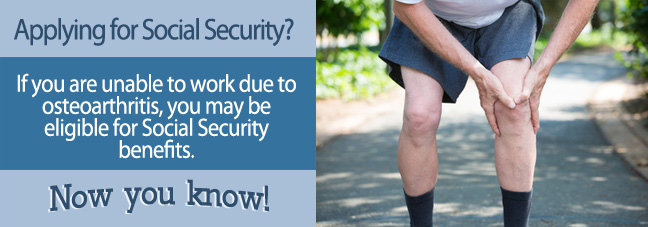Arthritis is the leading cause of disability in the United States, affecting 1 out of every four individuals. While many people think that arthritis is a single disease, it consists of over 100 diseases and conditions that cause inflammation of the joints. Osteoarthritis is the most common form of the disease, impacting approximately 27 million Americans. While osteoarthritis can affect anyone, it most commonly strikes those over the age of 50.
Depending on the severity of your osteoarthritis, you may have difficulty earning a gainful living. As such, it is possible that you could qualify for Social Security Disability Insurance (SSDI) benefits, particularly if you are over the age of 50.
The younger an individual is, the higher the burden of proof required when it comes to illustrating to the Social Security Administration (SSA) that you are unable to perform any type of work. The SSA recognizes that the older you are, the more difficult it becomes to find and adjust to new employment. Therefore, if you have osteoarthritis and are over the age of 50, your chances of being approved for Disability benefits improve.
Meeting a Blue Book Listing for Osteoarthritis
The SSA has broken down the human body and related health conditions into several distinct impairment categories, often referred to as the "Blue Book." This medical guide is used to determine what types of medical conditions and associated symptoms might qualify for disability benefits.
Osteoarthritis claims are likely to be evaluated under section 1.02, major dysfunction of a joint. Additionally, if your osteoarthritis has required a joint replacement, you might meet a listing in section 1.03, reconstructive surgery of a major joint.
If you experienced any of the following, you might meet a Blue Book listing:
- • A visible deformity of the joint, such as a dislocation, a contracture, or abnormal stiffening or immobility due to fusion of the bones.
- • Chronic joint pain and stiffness with limited ability to move the joint
To be approved for disability benefits, patients must have:
- • Involvement of one major weight-bearing joint such as the hip, knee or ankle that causes difficulty walking reasonable distances without assistance. For example, you must have the ability to travel without a companion to your place of employment.
OR
- • Involvement of one major peripheral joint in either the shoulders, elbows or hands that makes it difficult to perform fine and gross motor movements and to reach, pull or grasp. Examples of inability to perform fine motor skills include difficulty with personal hygiene or preparing a simple meal for oneself.

Grid Rules and Arthritis
If you are over the age of 50 and you do not meet a Blue Book listing, as described above, the SSA will then turn to its “grid rules” to determine your medical-vocational guidelines, take into account your age, level of education, work history, and any skills that you may have acquired over the years.
An SSA examiner will conduct a Residual Functional Capacity (RFC) assessment to help determine your physical capabilities. You will be assigned an RFC exertion rating ranging from sedentary to very heavy work.
As arthritis is such a common condition that affects so many older adults, your case must be unusually advanced or debilitating in order to be considered disabled. According to the SSA’s grid rules, the older, less educated, and fewer transferable skills that you have acquired from past employment, the more likely you are to be found disabled. For example, a 52-year-old with a 10th- grade education who has worked in a warehouse is much more likely to be awarded benefits for osteoarthritis than a 45-year-old college-graduated accountant.
What Type of Work Can Someone with Osteoarthritis Do?
As a general rule, the SSA recognizes that osteoarthritis can be uncomfortable, but unless severe, it’s generally not considered disabling. The type of work that someone with arthritis can perform will depend on the extent and location of the arthritis.
For example, if their arthritis is localized to their knees, they can likely still perform several sedentary jobs such as a telephone customer service representative or a secretary. However, it might be difficult for that same person to work as a security officer or a hostess at a restaurant.
Should I Discuss My Case with a Disability Lawyer or Advocate?
While as a general rule, less educated, unskilled workers over the age of 50 have a higher likelihood of being approved for disability benefits, this is not always the case. As osteoarthritis is such a common, and often mild, condition, the SSA is more stringent on its requirements for disability. While you may win approval through the use of the grid rules, they are complex.
An experienced disability attorney or advocate can help you understand the grid rules, as well as help you determine if your case is strong enough to win an approval. Disability lawyers have the inside knowledge and understanding of the SSDI process and thus can help structure your claim to enhance your chance for approval.